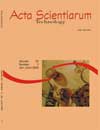<b>Development and appraisal of a Biogas CO<sub>2</sub> remotion system</b> - DOI: 10.4025/actascitechnol.v26i1.1537
DOI:
https://doi.org/10.4025/actascitechnol.v26i1.1537Keywords:
coluna de absorção, metano, energia renovável, gás naturalAbstract
The biogas is an alternative fuel produced by the biomass anaerobic digestion (organic waste) and is composed by methane and carbon dioxide. The shift in the composition of biogas is very important because it increases its use viability as biofuel. The remotion of carbon dioxide (CO2) increases the methane (CH4) concentration in biogas composition, making its heating value higher. A decrease of acid hydrosulphide (H2S) concentration reduces the corrosion produced during the use of biogas in thermal systems for the secondary energy production. This work aimed to develop a physical and chemical mechanism for biogas CO2 remotion. The device developed was an absorption column stuffed of 250 cm high and 30 cm of diameter, using pipe of PVC rigid of 20 mm of diameter as stuff and water as solvent. Tests were done with inside pressure and gas flow in the column between 300 and 500 kPa and 190 and 670 cm3/s. The original biogas has a concentration of 33% CO2. With the utilization of the column absorption a reduction in CO2 concentration of 15% was obtained, which showed an increasing of 57% in the lower heating value of biogas per unit of massDownloads
Download data is not yet available.
Downloads
Published
2008-03-31
How to Cite
Magalhães, E. A., Souza, S. N. M. de, Afonso, A. D. de L., & Ricieri, R. P. (2008). <b>Development and appraisal of a Biogas CO<sub>2</sub> remotion system</b> - DOI: 10.4025/actascitechnol.v26i1.1537. Acta Scientiarum. Technology, 26(1), 11–19. https://doi.org/10.4025/actascitechnol.v26i1.1537
Issue
Section
Chemical Engineering
License
DECLARATION OF ORIGINALITY AND COPYRIGHTS
I Declare that current article is original and has not been submitted for publication, in part or in whole, to any other national or international journal.
The copyrights belong exclusively to the authors. Published content is licensed under Creative Commons Attribution 4.0 (CC BY 4.0) guidelines, which allows sharing (copy and distribution of the material in any medium or format) and adaptation (remix, transform, and build upon the material) for any purpose, even commercially, under the terms of attribution.
Read this link for further information on how to use CC BY 4.0 properly.











8.png)




